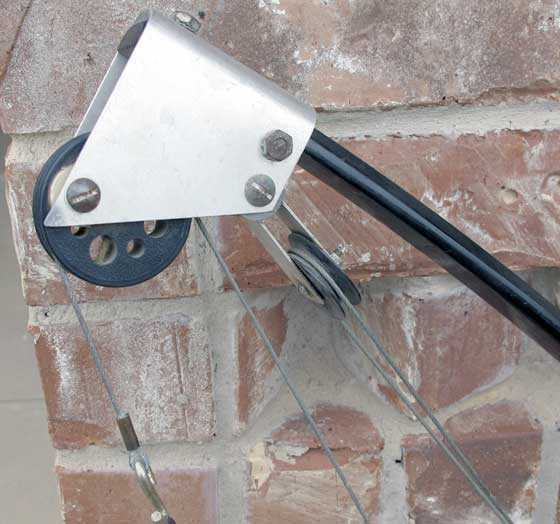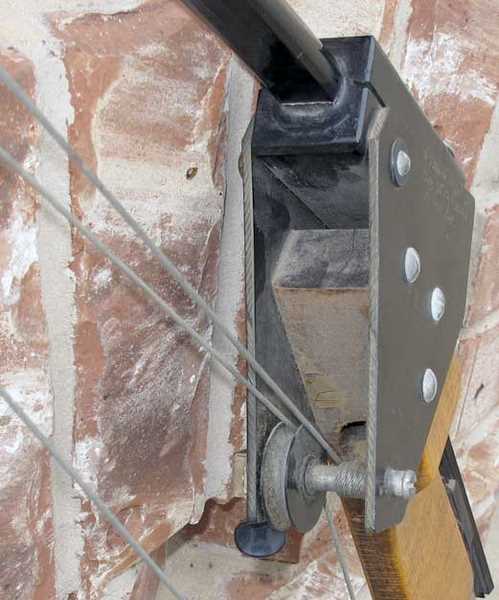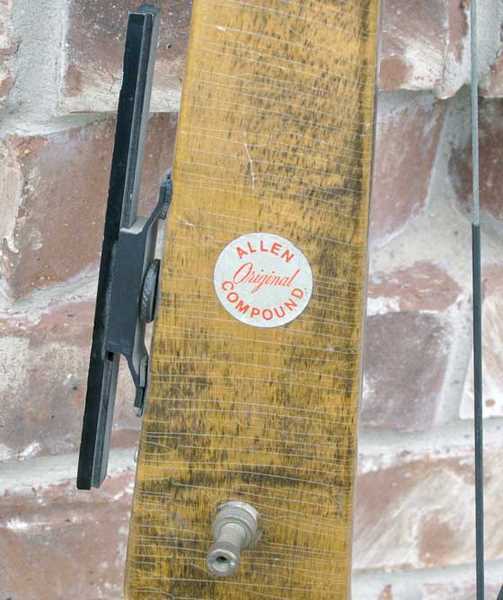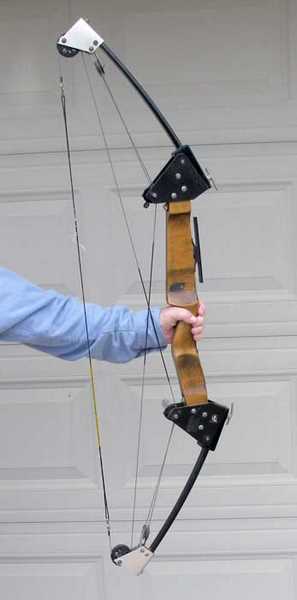by Tom Gaylord
Writing as B.B. Pelletier

This Allen bow is one of the first compound bows ever built. Allen invented the compound system!
This report covers:
- The first compound bow
- A gift!
- History
- Description
- Made for a southpaw!
- Bow data
- Tuning the bow?
- Dimensions
- Value
- Summary
I was looking for something completely different for today’s report. I was temporarily bored with my list of airguns to cover and I didn’t feel like another rant, so today I am reporting on something that is in the shooting sports, but a long way from airguns — the world’s first compound bow.
Discovery
About two months ago, and just before my town locked down for the Covid-19 pandemic, I was in my favorite pawn shop, looking to see what new/old things might have come in. Naturally I searched the whole store, as I always do. There are things on my watch list, like a long-bladed plain-head screwdriver with a wide tip, that I’m always searching for. I didn’t see anything interesting until the very end, when I spotted a strange and simple-looking compound bow standing in the corner by the gun rack. It looked homemade so I asked to see it. I wasn’t interested it it beyond seeing how it had been made. It looked for all the world like something that had been built from plans published in Popular Mechanics.
The first compound bow
As I was looking it over, Esther, the store owner who knows my eclectic tastes from my years of patronage, came over and told me it was the first compound bow. Well, it certainly looked like it! She told me it had been in her store for many years with absolutely zero interest, and I could see why. This wasn’t a bow anyone would ever shoot. And how many collectors of compound bows are there? About as many as there are collectors of 4-track tapes — yes, there is such a thing. Look it up! I did, and to my surprise I discovered there are even collectors of them! Okay — bad comparison.
But this bow is a different story. Most people buy bows to shoot. Looking at this one, I think that would be a very bad idea!
A gift!
As she was talking to me Esther surprised me by giving it to me. She said she wanted it out of her store and I could take it. Well, I had no idea of how much a thing like this is worth, and I certainly did not want it for myself, but I figured I could give it to an archer, so I accepted.
History
I came home and looked it up on the internet. It was marked as an Allen Patent, so I started (and ended) there. Sure enough, Holless Wilbur Allen (1908-1979) was the inventor of the compound bow! He developed his idea in the 1960s with the thought of making bow hunting easier. He sawed off the ends or a recurve bow and added pulleys to each end. His idea was to use a block-and tackle design to reduce the effort of holding the bow at full draw and also increase the speed of the arrow.
When was the compound bow invented?
The 1960s. Holless Wilbur Allen experimented with several designs and on June 23, 1966 he applied for a patent for the first compound bow. The U.S patent 3,486,495 was granted in December, 1969.

The patent drawing resembles the first bow very closely.
At first he approached several archery manufacturers to build his bow for him, but with no takers he started making them himself. He referred to his patented idea as an Archery Bow with Draw Force Multiplying Attachments — and began production in 1967. He said of it, “All I was trying to develop was a bow that would get an arrow to a 10- to 25-yard target — a deer — before the target could move.”
The technical editor of Archery World magazine (now Bowhunting World), Tom Jennings, reviewed the Allen bow in the May 1967 issue and said things like, “reduction in peak draw weight”, “more stable than recurves” and “the first really new concept to come into bow design in a thousand years.” He became the first to license the design rights from Allen who also licensed his design to four other companies, of which Browning Archery was probably the most successful.
The first compound bow was not readily accepted by the archery community. Given the size, weight and most of all the complexity, that isn’t surprising. But Tom Jennings, who was also a bowmaker, stepped in and in 1974 released his Model T that revolutionized the infant compound bow. Until Jennings Model T, compound bows were clumsy and complex.
While other companies were still using four and six wheels for their bows, Jennings Model T used only two. It was lighter, and easier to tune. Sales went from sluggish to brisk. By 1977 Archery Digest listed more than 100 models of compound bows and they had taken over the archery world.
Allen died from injuries sustained in a car accident in 1979. But he might have had had a succession plan set up because a company called Allen Archery still makes bows today.
Description
This first Allen bow is clunky compared to later designs. I’m not talking about the compound bows being made today — just those that were made soon after Allen started licensing his and the Jennings Model T came out.
The first Allen bow has six pulleys in the system That’s right — six! Two are at the end of each limb and the third is inside a guard on each end of the handle.

Two pulleys are at either end of the bow limbs. As you can see from the clasp at the bottom left, most of the bow is strung with stranded steel cable. The bowstring is just a short section in the middle, at the back of all the cables.

The third pulley on each side is attached to the bow’s handle.
At some point, Allen called his bow the Original. That is on a sticker on the bow I have.

My bow is an Allen Original. The black bar on front of the handle is for some accessory — probably a sight? And the arrow rest is on the left side of the bow.
Made for a southpaw!
Of all things, the bow I was given is made for a left-handed shooter. I didn’t figure that out. Reader Jeff Cloud who goes by the handle Cloud9 spotted it. It’s almost ambidextrous, which might have been intentional, but it does feel better when held by the right hand and the arrow is drawn with the left.
Bow data
Like all the bows I have seen, the data for the bow is written right on it. In this case it is inscribed with a vibrating pen on one of the black steel flanges that hold the limb to the handle and also anchor the single pulley.

The bow data was put on with a vibrating pencil. The model is 7306-10. The draw weight seems to be 50-60 pounds. The draw length is 29 inches and the L at the end of the serial number would seem to indicate a left-hand model. I can guess that the serial number indicates this bow was the 304th made in December of 1975.
Tuning the bow?
This is a subject I know nothing about, but I do see what look like stringed instrument tuning mechanisms that attach to the lone pulley on either side of the handle. A cursory examination indicates they move the axel of the pulley, which may change the mechanical advantage.

The lone pulley on either end of the handle has what looks to me like a stringed instrument tuner. It seems to move the center of the pulley axel.

This is what’s written on each “tuner.” I hope someone recognizes what this is.
Dimensions
This bow weighs 4 lbs. 4 oz, which seems light enough to me. It has an overall length of 50 inches, and of course the draw weignt has already been given.
Value
At some point in its run the 7306-10 model was called the Black Hunter. My bow has no such markings, but they may have been in the catalog and not on the bow, itself.
Expired listings on Ebay show asking prices for the standard model of $175-$195 without any bids. One that is active is up to $81 with 6 bids right now. There are several Buy it Now listings that sold for less than $150. So the value of these bows is not high. I guess that’s because they cannot be used anymore.
Summary
I think it’s interesting how the first compound bow is so relatively recent — or at least that’s how it seems to me. And also how quickly the archery community accepted the compound, once it was refined into a convenient form. The compound dominates center stage in the world of longbows today.


B.B.
Well that sure is an interesting piece! Invented in the 1960’s, popularised in th 1970’s…
Well the modern PCP “started” in the 1980’s and well today you know the rest….
So you are bored with all the airguns you are currently reviewing????
Not a good omen!
-Y
Yogi,
It was just a temporary thing. Back on track now.
B.B.
B.B.,
On the occasions when you do get bored, is it smooth or rifled? ;^)
Michael
Michael,
Ha ha! 🙂
B.B.
Kluson Deluxe tuners are tipically found in vintage and custom shop Gibson guitars, very well known brand, and well reputed too.
Macmaniacoes,
Thank you! I felt they were for guitars, but I didn’t know.
B.B.
BB,
I about wet myself when I saw the first picture. Back in the very early eighties I started fooling around with archery with a compound bow that looked almost identical to that one. I want to say it was a Jennings, but I was so stunned when I saw that bow, I cannot bring it to mind now.
Where you have the guitar tuners, mine had a ratcheting setup that used a “clock key” arrangement. It was neat as all get out and worked really nice, but was noisier than an old rattle trap pickup.
I have owned several compound bows throughout the years until my body said you are not going to play with those anymore. I hope it is a long time before my body says you are not going to shoot sproingers anymore.
BB,
A pretty cool find! Obviously,…. you must have walked past it many times as you frequented the pawn shop prior. Why did it catch your eye this time and not before?
Too bad that it is not worth more. Until you knew the value (after finding the history),…. I would imagine that you had visions of $$$ in you head? 😉
Chris
Chris,
I probably walked past it for many years. She had moved it over to the gun rack that I always check and that is why I noticed it.
I never intended to make any money from this. I told her if it turned out to be valuable I would split the profits with her, but I planned to give it away.
B.B.
BB,
It will make a very fine gift for an archer that can truly appreciate compound evolution and history. Just the fact that it is the (first) of the early, founding proto-types/production should make it very special. Plus,… a nice copy of your report to go with it! 🙂
Chris
My guess is it will end up on an archery shop wall somewhere until it is gifted again.
B.B.,
This is such an amazing find and blog subject I am stunned. Brilliant!
For anyone interested, here is a deep dive into the almost 100 year history of Kluson tuning machines:
http://www.rickn-guitars.com/tuners/kluson_ref.html
Michael
Still in business.
https://www.kluson.com/deluxe.html
JerryC,
Yes, and still a major brand and design in guitar tuners. Kluson (the brand) was sold to a company called WD Music Products back in the 1970s, I believe.
Michael
Michael,
Fascinating! I love gadgetry. It looks like they had the same plastic “issues” that many other plastic items suffered in the early days. Thanks for the history lesson.
Chris
Chris,
There are replacement plastic knobs available for restoration purposes, but yes, both the pearloid plastics and the white plastics they used in the 1950s and 1960s had a tendency to decay because of fumes they gave off in closed guitar cases. Guitars that were largely stored not in their cases but on a stand over many years tended to fare better.
Michael
B.B.,
I imagine the compound bow would make a useful visual aid in engineering classes. So, too, would a pump-assist mechanism multi-pump air rifle — I do hope Air Venturi still plans to bring one to the marketplace. :^)
Michael
“I do hope Air Venturi still plans to bring one to the marketplace.”
Michael, I am hoping and waiting on that, too! =>
Michael,
Isn’t that what the Nova Vista Freedom/Air Venturi/Seneca Aspen is?
RidgeRunner,
The Nova Vista Freedom / Seneca Aspen is a self-contained PCP. The Air Venturi pump-assist multi-pump will be (The davemyster and I hope) a multi-pump with the pump-assisting mechanism of the never-emerged-from-its-chrysalis Crosman “Butterfly” and Benjamin Pump-Assist. Imagine pumps 6-8 taking no more effort than pumps 1-3 on a Daisy 880.
Look for it in one of B.B.’s most recent Shot Show blogs.
Michael
RidgeRunner,
You gave me a wonderful excuse to go back and reread it: /blog/2020/01/2020-shot-show-day-two/
Michael
For what its worth, I was told a story about Fred Bear and the Allen Bow. Fred had turned down the chance to buy the Allen Patent. A friend of his stopped by and since Fred still had the bow, he showed it to him. The man pulled the bow back and when he felt the poundage drop he looked at Fred and said, “I want one, and also one for my wife and son.” At that point Fred thought that he may have made a mistake.
Mike
You said you thought the tuning mechanism might change the mechanical advantage of the bow. Don’t think so. It appears all it does is adjust the tension in the cable on each side of the bow. Turning the adjuster knob wraps the cable around the axle, more or less as needed to balance the tension in the cables.
Radfordc,
Yes, you are correct; you need to balance the tension in the cables; and, according to my archery friend, Efrem (a huge compound bow user, who gets several deer [legally] with an 80-pound compound [he’s strong, too, way stronger than me!], the timing of the cams is also critical. I’m no expert at this; for the one compound bow I owned, he tuned it up for me. =>
Take care, stay safe, have a blessed day,
dave
https://shootingtime.com/archery/tuning-a-bow-timeline/
B.B.,
You were right when you said, “The black bar on front of the handle is for some accessory — probably a sight? ”
Here’s a picture of that black bar on an Allen Compound bow that has the sights attached:
Nice pic! =>
Kevin,
Thank you for that! I am learning as much as anyone today! 🙂
B.B.
BB,
How much let off would you estimate it has?
Brent
Brent,
I don’t understand the question.
B.B.
How much does the effort decrease when you draw it?
Brent,
Thanks. As you know, I don’t know much about compound bows.
To answer you, I haven’t got a clue. I would imagine some, but not much. I think the technology has improved a lot over the years. In fact, I wondered if that was what 50/60 lbs. meant in the tech inscription.
B.B.
B.B.,
This is a great report on a real piece of shooting history!
I had a compound bow once, but I had to sell it and get a longbow when I started shooting black powder matches. The only permissible bows for the follow-on archery match were bows from that same time period; hence, they did not even allow recurve bows. But some of those old boys were pretty accurate with those old long bows. One guy, a retired gent, who shot his bow for like 8 hours a day (after practicing his black powder shooting…nice life, huh?), could easily hit a small pine cone at 25 yards…and that’s with no sights of any kind, of course. =>
Take care, stay safe, and thanks for another great report,
dave
B.B.
The Klusons make this piece better. Give it some more time for value, 50yrs?
I love antiques roadshow!
Thanks,
Rob
Rob,
I have a few dozen old Klusons, but they are attached to a half dozen old Gibsons! :^)
Michael
BB,
Back to that silk purse. If I have to load and shoot it one at a time I would just as soon have a Sharps. At least it would look nice while doing it.
Shootski,
When you can get a Mattelomatic to shoot 1/3 MOA at 300 yards, I’ll be impressed.
RR,
The guy who competed with my upper told me he shot five into 6 inches at 600 yards. I didn’t see the target, that’s just what he told me. I did put 10 into 3/8-inches at 100 yards.
B.B.
BB
Is your AR for sale?
GF1,
No. I’m keeping it.
B.B.
BB
I had to ask.
RidgeRunner,
Sorry couldn’t find any that big at 300…
As they say, “Read ’em…”
https://www.google.com/search?q=record+ar15+group&oq=record+ar15+group
shootski
BB
Interesting report.
I never gave it a thought about when compound bows came about.
If someone was to give me a million dollars if I knew the answer of when they came about. I wouldn’t of never guessed.
I’m an admitted luddite 🙂
Here’s my bow (actually a pic of it from the sellers website)
Cowboystar Dad
In the mid 1970s I remember listening to my bow hunting coworkers hotly debate the merits and shortcomings of the bows like yours and the recurve bow. It was rare to have anyone chime in with an opinion on a compound bow. Then suddenly compound bows were about all I would hear discussed. I guess I know why now. I didn’t realize that they were a new developement. I wonder if the Airbows will soon be the new norm?
Half
Compound bow is basically used for hunting. It helps us to catch our prey. if you want to go on hunting, you should equip the best gear to avoid unexpected circumstances. you should give visit to this website which provides the
best compound bows.